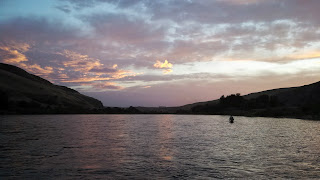Dry fly fisherman often think of themselves as the most refined of all anglers. Truly, convincing a selective trout to sip your mayfly imitation from the midst of dozens of real mayflies is a bona fide fishing accomplishment. Of course you know the fish is there. You know the fish is eating. Sure you might spook a fish with a sloppy cast, but half the battle is already won. Fishing with nymphs and other wet flies, you have to read the water, understand the currents, know the fish's habits, and have a little faith that the fish are there.
Catching fish under the surface actually requires three things to occur simultaneously. First, the fish needs to be there. Just because you are fishing good habitat, doesn't necessarily mean there is a fish in it. Second, you have to get the fly into the fish's wheel house. Those currents are complex and, sometimes, the river is deep. Getting the fly where it is supposed to be is sometimes a tricky business. Make a cast to the right spot, sometimes way upstream of your target, make a mend to get the fly on the proper course. Make another mend, get the tension off of the line, let the fly sink, and drift it into the wheelhouse as naturally as is possible. Third, the fish must strike. Just because the fly is in the wheelhouse, doesn't mean she will eat. You have to do your very best with a bunch of wire, feathers, yarn, plastic thread, and graphite to make the connection between this world and theirs.
Lately, I have been making a new foray into the ways of knowing fish. Our home is only hundreds yards from one of the finest (well, most popular) steelhead runs on the Clearwater River, one of the more storied steelhead rivers in the Pacific Northwest. Don't get imagery of a rustic lodge on the banks of a pristine wilderness river. Our's is a blue collar run. There is a four lane highway, a series of pump houses, and most imposingly, a gigantic paper mill whose airborne effluent occasionally wafts across the waters to greet the angler with a powerful scent. It is called the Stink Hole for a reason. The Stink Hole, along with the rest of the Clearwater (which is more scenic), the Snake, the Salmon, and the Grande Ronde, are all outr my back door, and all of them fill up with steelhead each fall, destined for the wild streams and hatcheries of Idaho, Washington, and Oregon. Anglers descend by the thousands on each of these rivers with all varieties of tackle to pursue steelhead. Since moving to Lewiston, I have watched anglers use each of these approaches, studying in an attempt to understand how to commune with this most fickle of fish. I myself have dabbled in several of these methodologies, but one has intrigued me above all others: swinging flies with a two handed fly rod.

I am a fisheries biologist. I study how many fish there are and how people interact with them for a living. I know that swinging flies is, relatively speaking, an ineffective way to fish for steelhead. If you are in it for numbers, probably better be back-trolling plugs or side drifting eggs from a boat. Truly, I want numbers too, and once the harvest season opens, I want to abruptly end the return migration of a few hatchery fish in my freezer. So why take up the study of a fishing technique doomed to relative failure? The answer can only be in the aesthetics of a well executed spey cast, and the prospect of those rarer successes being so sweet.

I am human. Sometimes I let the downer parts of life try to get the better of me. Lately, I have fought back against that negativity by devoting myself to the pursuit of that graceful cast and the connection with that mysterious fish. The purpose of spey casting is to re-direct a very long reach of flyline, casting it from a drift that has ceased to be useful into one that may better yield the object of one's ambition. There are many ways to know God, to struggle to understand the higher meaning, to replenish your soul. I have nothing against it, but church pews and pastors haven't ever worked too well for me. There is a song that I love on a favorite album... "Church of the Wandering Stream." Somehow whenever I find myself revitalized, it is near running water. Often, I have a rod in my hand and faith that amid the complex currents of both life and rivers, my fly will end up in the right place to trigger a strike.







